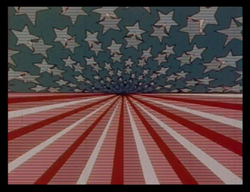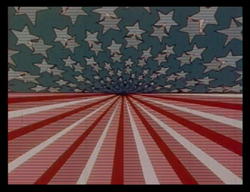Kaleidoscreen
Opening Hours: daily from 11 a.m. - 6 p.m., free admission
Artists | Katharina Cibulka, Philipp Fleischmann, Paul Gründorfer, Muzaffer Hasaltay, Julia Hohenwarter, Steffen Jørgensen, Robert Kjær Clausen und Allan Nicolaisen, Christoph Kolar, Philipp Leissing, Johann Lurf, mara (Serigne Mor Niang), Kader Muzaqi, Jascha Novak, Franziska Pflaum, Linda Reif, Patrick Schabus, Christine Schörkhuber, Jennifer Tischer
Auditorium | Ernst Gruber, David Stöger and Alexandre D'Aram
Opening, 8 April 2008, 7 pm
Diana Baldon
in conversation with Matthias Michalka , curator MUMOK, Stuart Comer , curator of film at Tate Modern and Dorit Margreiter , Professor for Video and Videoinstallation at the Academy
As a tribute to the seminal experiments in cinema design by Austrian precursors like Friedrich Kiesler and Peter Kubelka, and the “cinema palaces” built in Europe and North America during the 1920s-30s, this show presents an environment conceived by students of the Art and Architecture Department screening a programme of videos by artists of the Academy. In the years when cinema display looked into perfecting the power of filmic illusion, Walter Benjamin explored the modalities of the “collective” and “distracted” perception of the public. Seventy years on, we have grown familiar with the ubiquity of projection screens pervading the contemporary media environment. “Kaleidoscreen” revisits such ideas to question why auditoriums didn’t historically exploit the power to gather people together and didn’t manage to take on an equal role of projection screens. This stage-display proposes an alternative model abolishing the fixed viewpoint of classical perspective to play instead with disorientation. It turns the attention back to cinema-going as a social experience to be consumed in semi-obscurity, highlighting such physical presence as a form of collective escapism opposed to the bodiless, space-less sensation of celluloid space or the purist, black box machine for film viewing.
The programme brings together a range of videos exploring the medium along multiple strands, from script writing to meditations establishing dialogues between images. For instance, Schörkhuber’s “syn -Etüden zur Geräuscherfahrung” (2007) makes use of the technological help and restrictions of digital audio-visual cuts to compose short musical pieces recalling Pierre Schaeffer’s Musique Concrète. Differently, Julia Hohenwarter’s animation “4254,8 GRAMM” (2007) is based on J.G. Ballard’s short story “The Concentration City” (1957) which narrative informs the modelling of a two-dimensional city and interrogates the boundaries of space. Philipp Leissing’s “Pictures at the Pictures” (2006) instead is based on a sequence shot in New York’s Metropolitan Museum of Art taken from Brian De Palma’s film “Dressed To Kill” (1980): having removed the interior and the characters, this operation brings the paintings to float on an indefinite black wall, thus reversing the relation of essential and inessential information. (DB)
Special thanks to: Gabu Heindl, Tom Holert, Dorit Margreiter, Axel Stockburger
Katharina Cibulka
Stressed Out, 2006
DV video, colour, sound, 3:50
min.
Reflecting upon Faith Wilding’s 1972 performance “Waiting” which turned a woman’s entire life into a monotonous, repetitive cycle of wait that her life begins while still serving other people’s life,
”Stressed Out” describes on the other hand the busy and hectic life of a 21st century woman, feeling permanently in haste to comply with all kinds of personal and social expectations.
Katharina Cibulka
Born in Innsbruck, Austria, in 1975, lives and works in Vienna. Cibulka is filmmaker and since 2004 she is enrolled in the Fine Arts study program at the Academy of Fine Arts Vienna (Prof. Peter Kogler, Art and Digital Media, and Prof. Carola Dertnig, Performative Art). Since this time her films and works are shown on numerous exhibitions and film festivals.

Philipp Fleischmann
Who’s that girl?, 2008
Video, colour, 14:25 min.
How to deal with the phenomenon of stardom? The video describes it by means of a music star’s statements carried out for numerous TV and magazines interviews over a period of 25 years. It revisits important key moments of her career shown as a long, continual interview that takes place in replicas of the original sets, (re)locating her statements in the context within which the conversations formerly happened.
Philipp Fleischmann
Born in Austria in 1985, lives and works in Vienna.

Paul Gruendorfer
Rasenmäher [lawnmower], 2006
Video, colour, sound, 17:15 min.
Filmed from a distance, a lawnmower slowly mows the grass of a green lawn in a circle. The camera remains in the same position and angle throughout the whole length of the video.
Paul Gruendorfer
Born in Austria in 1982, lives and works in Vienna.

still from the video "Rasenmäher" [lawnmower], 2006
Muzaffer Hasaltay
The Friend, 2007
HDV 720p transferred onto (HD)DVD, colour, sound, 12:29
min.
In the evening of a difficult day, Osi and Murat met in the park, their former football cage. The meeting builds up dramatically.
Muzaffer Hasaltay
Born in Austria in 1979, lives and works in Vienna.

still from the video
"The Friend", 2007
Julia Hohenwarter
4254,8 GRAMM – Modelle für eine Stadt, 2007
Photo animation and video, B/W, sound, 5:21 min. (originally looped)
“4254,8 GRAMM” is based on J. G. Ballard’s short story “The Concentration City” (1957) whose narrative informs the modelling of a two-dimensional city and interrogates the boundaries and centres of space. This is shown two-dimensionally only – reduced to lines and surfaces – in order that the perspectives of the virtual, constructed space reflect the viewers’ position in the real space.
Julia Hohenwarter
Born in Austria in 1980, lives and works in Vienna.

Steffen Jørgensen, Robert Kjær Clausen und Allan Nicolaisen
Cornucopia, 2008, DVD/Pal, colour, sound, 17:40 min.
An increasing number of villains come to inhabit a black pyramid. A cornucopia on the top of the pyramid tempts them with its evil hoot. They violently fight, some are killed but in the end they all turn out to be unharmed. When the pyramid is completely occupied, the cornucopia releases a colourful liquid that rains over the characters; a whale rises and in its belly a skeleton plays a song transforming these villains into inanimate objects.
Steffen Jørgensen, Robert Kjær Clausen, Allan Nicolaisen
Born in Denmark in 1982, 1979, and 1982, live and work in Vienna.

still from the video "Cornucopia", 2008
Christoph Kolar
United Nation Resolution 1244 Kosovo/Prishtina, 2006
B/W and colour 16mm film transferred onto DVD, 4:05 min.
Mixing scenes shot on the streets of Prishtina and sections of the text formulated for United Nations Security Council Resolution 1244 which made Kosovo a UN protectorate and signed the end of the war in former-Yugoslavia, two kinds of language are put in a direct confrontation to underline striking keywords.
Christoph Kolar
Born in Vienna, Austria, in 1971, lives and works in Vienna.
Kolar studied with Friedl Kubelka and Valie Export, since 2006 he is enrolled in the Fine Arts study program at the Academy of Fine Arts Vienna (Prof. Marina Grzinic, Conceptual Art).

Philipp Leissing
pictures at the pictures, 2006
DVD/Pal/16:9, colour, sound,
8:50 min.
“pictures at the pictures” is based on a sequence shot in New York’s Metropolitan Museum of Art taken from Brian De Palma’s film “Dressed To Kill” (1980) in which interiors and characters are removed to let paintings float within an indefinite black space that overturns the relationship between essential and inessential information.
Philipp Leissing
Born in Austria in 1983, lives and works in Vienna.

Johann Lurf
Untitled, 2003
DV, colour, sound, 3:00 min.
Appearing at different times against a black background, twelve simultaneously running scenes fill the screen, synchronising their climax with the fatal moment of a gunshot.
Johann Lurf
Born in Austria in 1982, lives and works in Vienna.

mara (Serigne Mor Niang)
Bob Marley & the Wailers, 2007
DVD, colour, sound, 1:56 min.
mara (Serigne Mor Niang)
Born in Senegal in 1972, lives and works in Vienna.

Kader Muzaqi
Balkan is different / Ballkani osht ndryshe, 2005
DVD Pal, colour, sound, 3:47 min.
The video describes the pressures and life threats caused by the necessity to own an apartment in which to live and accomplish a brilliant idea to realise an artwork that would make an artist famous. In the depressive atmosphere of the place, the voice tells of the obstacles and impossibility to be successful and respected as an artist practicing within a society – that of the Balkans – where there is no real understanding of this role, and where aspiring young artists are unable to achieve their ambitions.
Kader Muzaqi
Born in Kosovo in 1985, lives and works in Vienna.

Jascha Novak
Ramus, 2008
16mm film transferred onto DVD, B/W, 4:20 min.
“Ramus” takes you for a spiralling ride through a mysterious maze of pipes, tunnels and tubes. Surprisingly, the camera itself is static all the time. Simply by projecting shadows on the tube from the outside the impression of movement is created on the inside. With the help of double-, triple exposure and split screens the spectator suddenly feels lost in space and time. Rewinding the film and partly masking the frame of the 16 mm camera generate all these effects.
Jascha Novak
Born in Austria in 1983, lives and works in Vienna.

Franziska Pflaum
Schwanensang, 2007
Mini DV transferred on DVD,
B/W, sound, 7:40 min.
Two girls fight in the middle of a desolate industrial site. Their weapons are monumental penises. The host of the show, a woman dressed in nice clothes, voices poems by Bertold Brecht about sex, gender and manhood while playing classical music to amuse herself. Stabbing, falling, slashing: the show is over, the sun shines and the curious spectators leave the scene.
Franziska Pflaum
Born in Vienna, Austria, in 1987, lives and works in Vienna. She is enrolled in the Fine Arts study program at the Academy of Fine Arts Vienna (Prof. Constanze Ruhm, Art and Digital Media).

still form the video "Schwanengesang", 2007
Linda Reif
western spaghetti, 2001
MDV transferred onto DVD, colour, sound, 0:50 min.
A Spaghetti Western drama about mafia control.
Linda Reif
Born in Austria in 1980, lives and works in Jerusalem and Vienna.

Patrick Schabus
Zone of Subordination, 2008
DVD, colour, sound, 15:00 min.
With an interest in the (mis)use of propaganda by American, German and Austrian newsreels, radio and film media, this video juxtaposes a misinformational animation by Vincent Collins to the beginning of Lars von Trier’s filmic trilogy “Europa”. As a consequence, the formal aspect of the footage mutates and reveals the encrypted message as a form of mass indoctrination.
Patrick Schabus
Born in Austria in 1978, lives and works in Salzburg and Vienna.

Christine Schörkhuber
Syn10 Kreissäge, 2007
Mini DV PAL transferred onto DVD, colour, sound, 1:40 min.
Syn9 Glas, 2007
Mini DV PAL transferred onto DVD, colour, sound, 2:40 min.
The series “Syn” makes use of a few seconds of video footage to compose musical scores out of a predominantly visual medium. The relation established by the layers of repetitions, loops and changes of duration follow the compositional methods employed by Pierre Schaeffer for his “Musique Concrète”, with the difference that here the system is helped and at the same time restricted by digital audio-visual cuts running in parallel.
Christine Schörkhuber
Born in Austria in 1982, lives and works in Vienna.

"Syn10 Kreissäge", 2007

"Syn9 Glas", 2007
Jennifer Tischer
Situationsabhängige, notwendige Verhaltensweisen, 2007
video, colour, sound, 7:38 min.
A Mercedes car drives through a deserted forest that separates the border between former West and East Germany. The radio airs an interview with the German Prime Minister Angela Merkel who is talking about the meaning of speech and silence these days and in the former GDR, where she has grown up.
Jennifer Tischer
Born in Germany in 1979, lives and works in Vienna.

still from the video "Situationsabhängige, notwendige Verhaltens- weisen", 2007
Ernst Gruber, David Stöger, Alexandre D’Aram
Let there be light..., 2008

List of entries
-
Kaleidoscreen
Opening Hours: daily from 11 a.m. - 6 p.m., free admission
Opening
Aula, Demonstrationsraum
Academy

